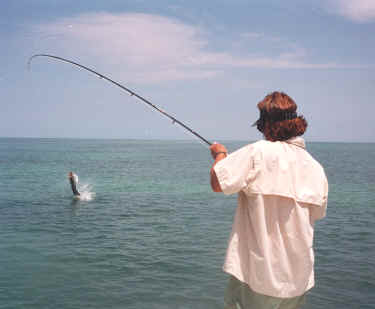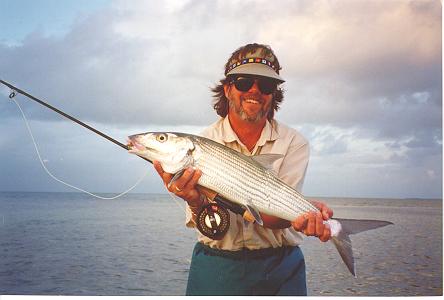 Part of the
Part of theFISHING THE FLORIDA KEYS
Series
Fly Fishing in the Florida
Keys
 Part of the
Part of the
FISHING THE FLORIDA KEYS
Series
![]()
 Are you a a freshwater fly
fishing enthusiast looking to challenge your skills at the next level?
Are you a a freshwater fly
fishing enthusiast looking to challenge your skills at the next level?
Maybe you've been pounding away at New England stripers and blues on fly for years, and now you're cosidering the prospects of fly fishing in the Florida Keys.
Perhaps you have no flyfishing experience at all, but you've seen the Saturday morning fishing shows featuring great gamefish being caught in our pristine backcountry waters. And by golly, it looks like fun!
Before you pack your gear up and head on down here, there are a few things that you should know before you go.
The Eyes Have It
In most cases, an angler must first see the fish before a cast is ever made. Thus, it's vey important to have the right sunglasses or you're just wasting your time out there. Polarized lenses are a must. Just as important as polarization though is the correct shade. Go with light brown. Not green, not grey, but light brown polarized sunglasses...this is the most important investment you'll make in your upcoming flats fishing trip. If you have money burning a hole in your pocket, get an amber pair of polarized sunglasses as well. These may prove very helpful on overcast days or low light conditions. Remember...you can't catch what you can't see!
The Answer Is "Throwin' in the Wind."
Okay, so maybe we're doing Bob Dylan a great injustice here, but one of the most important skills a stream, river or even inland lake fly fishermen must aquire to be successful in the Keys is the ability to cast in a wind. This will affect the gear you use as well as your casting technique.
Overlining is a typical ploy for allowing an angler to cast in (and quite often into) a wind. For instance, if you are using an 8 wt outfit, it is a common practice to use a 9 wt line with it. The heavier line is also helpful when launching some of the larger bulkier patterns (crab and large spun deerhair heads) into a wind.
Another method of dealing with the wind is to go to an intermediate line (which has more density for the diameter than does a floating line). A favorite of mine is the Mastery Series clear intermediate by Scientific Anglers (often referred to as a "slime line"). It has the added advantage of being less visible in the air than the floaters.
The slimeline is a two-edged sword however; although it casts well, it's slow sinking feature means that a large portion of the flyline will have to be retrieved before a recast is possible. This can be a major disadvantage, and can sometimes kill a second shot opportunity.
The other difference that wind causes is related to your casting technique. You will be at a severe disadvantage unless you can double haul. This is a powercast that takes full advantage of the cooordinated effort between the casting arm and the stripping hand. Although this wouldn't be the proper forum for a step by step walkthrough of the double haul, by all means learn it and practice it as much as possible if you want to fish effectively in the Keys.
One more thing...without meaning to be unkind, let me say that if you've been to the Bahamas and caught the heck out of bonefish on fly there, don't think that means you're in good shape to do it here. Fact is, the majority of Bahamas' bones are caught by casting into a school of mudding "LDF's" (little dumb fish). These bones will often fight each other for your fly. Accuracy isn't critical... just "Cast to da smoke, mon." as your Bahamian guide would say. An angler can rack up some pretty impressive numbers over there and come away with a pretty big ego concerning his fly fishing prowess. Did the angler have fun? You bet he did! Was his casting accuracy challenged? Not really.

It's different here. Often you are casting to small groups of larger fish, and quite often, to a single or a pair of tailers. And these big bonefish didn't get big by being dumb. They can be very spooky, meaning it's not just distance but accuracy that's important here in the Keys. Do your homework if at all possible and practice your double haul for distance and accuracy.
The Right Rig?
The saltwater flyfishing bug is a nasty disease which has many manifestations, the most obvious (and dangerous) of which is the compelling need to go out and purchase large amounts of new tackle.
What tackle you need will be determined by what fish you are targeting. A person can rack up some serious credit card debt in a hurry when it comes to flyfishing in the Florida Keys. But if you had to bring just one outfit to the Keys, you'd want a 9 weight. This would cover almost everything you could fish for down here except large tarpon and the bigger sharks. The 9 has enough feel to it to provide plenty of enjoyment, yet has the power to punch a line across (or into) the wind.
The larger outfits (10-12wt) can easily run $800-$1000 and the guides down here will already have them anyway. Until you're condition deteriorates into the advanced stages of this disease (whereby an aggressive regimen of tackle purchasing therapy is indicated), stick with a nine weight for the time being, and let the guide foot the bill for the expensive gear.
![]()
About the Author
 Captain Buddy LaPointe is a cum laude graduate of Pensacola
Christian College, and has over 20 years experience charter fishing in the Florida
Keys. He has been featured on Mark Sosin's Saltwater Journal,
(seen weekly on national television), as well as in Florida Sportsman
and in the Outdoors section of the Miami Herald. Capt.
Buddy has written numerous articles for Sport Fishing Magazine, Saltwater
Sportsman, Fishing the Florida Keys, and the Florida Keys
Keynoter.
Captain Buddy LaPointe is a cum laude graduate of Pensacola
Christian College, and has over 20 years experience charter fishing in the Florida
Keys. He has been featured on Mark Sosin's Saltwater Journal,
(seen weekly on national television), as well as in Florida Sportsman
and in the Outdoors section of the Miami Herald. Capt.
Buddy has written numerous articles for Sport Fishing Magazine, Saltwater
Sportsman, Fishing the Florida Keys, and the Florida Keys
Keynoter.
![]()
|
HOMEPAGE | ARTICLES | EMAIL/FEEDBACK |